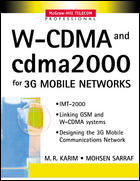UMTS: The Fundamentals
暫譯: UMTS:基本原理
Bernhard H. Walke, P. Seidenberg, M. P. Althoff
- 出版商: Wiley
- 出版日期: 2003-06-27
- 售價: $5,600
- 貴賓價: 9.5 折 $5,320
- 語言: 英文
- 頁數: 324
- 裝訂: Hardcover
- ISBN: 0470845570
- ISBN-13: 9780470845578
海外代購書籍(需單獨結帳)
買這商品的人也買了...
-
 計算機組織與設計--軟硬體界面第二版 (Computer Organization & Design, 2/e)
計算機組織與設計--軟硬體界面第二版 (Computer Organization & Design, 2/e)$680$537 -
 OpenGl 超級手冊 (OpenGL Super Bible, 2/e)
OpenGl 超級手冊 (OpenGL Super Bible, 2/e)$680$537 -
 PhotoImpact 實力養成暨評量
PhotoImpact 實力養成暨評量$380$300 -
 SQL 語法查詢百科 (SQL Fundamentals, 2/e)
SQL 語法查詢百科 (SQL Fundamentals, 2/e)$720$569 -
 Visual C#.NET 程式設計經典
Visual C#.NET 程式設計經典$650$514 -
 作業系統概念 (Operating System Concepts, 6/e Windows XP Update)
作業系統概念 (Operating System Concepts, 6/e Windows XP Update)$780$741 -
 Delphi 7 程式設計快樂上手(含資料庫)
Delphi 7 程式設計快樂上手(含資料庫)$640$576 -
 ASP.NET 程式設計徹底研究
ASP.NET 程式設計徹底研究$590$466 -
 用實例學 ASP.NET:使用 VB.NET 與 ADO.NET(2003修訂版)
用實例學 ASP.NET:使用 VB.NET 與 ADO.NET(2003修訂版)$620$490 -
 C# Primer Plus 中文版 (C# Primer Plus)
C# Primer Plus 中文版 (C# Primer Plus)$680$537 -
 鳥哥的 Linux 私房菜─基礎學習篇增訂版
鳥哥的 Linux 私房菜─基礎學習篇增訂版$560$476 -
 JSP 2.0 技術手冊
JSP 2.0 技術手冊$750$593 -
 最新 JavaScript 完整語法參考辭典 第三版
最新 JavaScript 完整語法參考辭典 第三版$490$382 -
 演算法使用 C++ 虛擬碼 (Foundations of Algorithms Using C++ Pseudocode, 3/e)
演算法使用 C++ 虛擬碼 (Foundations of Algorithms Using C++ Pseudocode, 3/e)$680$537 -
 Linux 實戰手冊-入門、管理、架站
Linux 實戰手冊-入門、管理、架站$580$458 -
 ASP.NET 徹底研究進階技巧─高階技巧與控制項實作
ASP.NET 徹底研究進階技巧─高階技巧與控制項實作$650$507 -
 深入 Linux 建構與管理, 5/e
深入 Linux 建構與管理, 5/e$720$569 -
 Oracle 10g 資料庫管理實務
Oracle 10g 資料庫管理實務$680$537 -
 MAYA 進化論 I─模組介紹與實作
MAYA 進化論 I─模組介紹與實作$680$578 -
 JSP 2.0 網頁設計範例教本
JSP 2.0 網頁設計範例教本$650$553 -
 網路電話(IP 電信)系統規劃與建置 (IP Telephony System Planning and Implementation)
網路電話(IP 電信)系統規劃與建置 (IP Telephony System Planning and Implementation)$420$332 -
 Sniffer Pro 網路最佳化與故障排除手冊
Sniffer Pro 網路最佳化與故障排除手冊$580$452 -
 SCWCD 認證專家應考指南, 2/e
SCWCD 認證專家應考指南, 2/e$790$672 -
 駭客現形 (Hacking Exposed, 5/e)
駭客現形 (Hacking Exposed, 5/e)$860$731 -
 抓住你的 Photoshop CS2 中文版
抓住你的 Photoshop CS2 中文版$650$514
商品描述
Description:
UMTS (Universal Mobile Telecommunication System) is the third generation telecommunications system based on WCDMA. WCDMA (Wideband Code Division Multiple Access) is the radio interface for UMTS. WCDMA is characterised by use of a wider band than CDMA. It has additional advantages of high transfer rate, and increased system capacity and communication quality by statistical multiplexing, etc. WCDMA efficiently utilises the radio spectrum to provide a maximum data rate of 2 Mbit/s.
UMTS (Universal Mobile Telecommunication System) will offer a consistent set of services to mobile computer and phone users no matter where they are located in the world. Based on the GSM (Global System for Mobile communication) communication standard, UMTS, endorsed by major standards bodies and manufacturers, is the planned standard for mobile users around the world by 2002.
Today's cellular telephone systems are mainly circuit-switched, with connections always dependent on circuit availability. Packet-switched connection, using the Internet Protocol (IP), means that a virtual connection is always available to any other end point in the network. It will also make it possible to provide new services, such as alternative billing methods (pay-per-bit, pay-per-session, flat rate, asymmetric bandwidth, and others). The higher bandwidth of UMTS also promises new services, such as video conferencing and promises to realise the Virtual Home Environment (VHE) in which a roaming user can have the same services to which the user is accustomed when at home or in the office, through a combination of transparent terrestrial and satellite connections.
- Provides an introduction to cellular networks and digital communications
- Covers the air interface, radio access network and core network
- Explains the Release '99 specifications clearly and effectively
- Discusses UMTS services and future services beyond 3G
- Features numerous problems and solutions in order to aid understanding
Ideal for Academics and students on telecommunications, electronics and computer science courses, research and development engineers working in mobile/wireless communications and Cellular operators and technical consultants.
Table of Contents:
Preface.
Digital Data Transmission.
Cellular Mobile Radio Networks.
Standardisation and Spectrum.
UMTS System Architecture.
The Protocol Stack at the Radio Interface.
Data Transmission at the UMTS Radio Interface.
The Physical Layer at the Radio Interface.
Physical Channels and Procedures at the Radio Interface.
Cellular CDMA Networks.
Service Architectures and Services in UMTS.
The Next Generation of Mobile Radio Systems.
Answers to Questions.
List of UMTS Release 4 Specifications.
Acronyms.
Index.
商品描述(中文翻譯)
**描述:**
UMTS(通用行動通信系統)是基於WCDMA的第三代電信系統。WCDMA(寬頻碼分多重存取)是UMTS的無線介面。WCDMA的特點是使用比CDMA更寬的頻帶。它具有高傳輸速率、系統容量增加和通訊質量提升等額外優勢,這些都是通過統計多工等技術實現的。WCDMA有效利用無線頻譜,提供最高2 Mbit/s的數據傳輸速率。
UMTS(通用行動通信系統)將為行動電腦和手機用戶提供一致的服務,無論他們身在世界的哪個角落。基於GSM(全球行動通信系統)通信標準,UMTS得到了主要標準機構和製造商的支持,計劃於2002年成為全球行動用戶的標準。
當今的行動電話系統主要是電路交換的,連接始終依賴於電路的可用性。使用網際網路協議(IP)的封包交換連接意味著虛擬連接始終可用於網路中的任何其他端點。這也將使提供新服務成為可能,例如替代計費方法(按位計費、按會話計費、固定費率、不對稱頻寬等)。UMTS的更高頻寬也承諾提供新服務,例如視訊會議,並承諾實現虛擬家庭環境(VHE),在這種環境中,漫遊用戶可以通過透明的地面和衛星連接獲得與在家或辦公室時相同的服務。
- 提供行動網路和數位通訊的介紹
- 涵蓋空中介面、無線接入網路和核心網路
- 清晰有效地解釋Release '99規範
- 討論UMTS服務及超越3G的未來服務
- 特別列出許多問題和解決方案以幫助理解
非常適合學術界和學習電信、電子和計算機科學課程的學生,以及在行動/無線通訊領域工作的研究與開發工程師、行動運營商和技術顧問。
**目錄:**
前言。
數位數據傳輸。
行動無線電網路。
標準化與頻譜。
UMTS系統架構。
無線介面的協議堆疊。
UMTS無線介面的數據傳輸。
無線介面的物理層。
無線介面的物理通道和程序。
行動CDMA網路。
UMTS中的服務架構和服務。
下一代行動無線系統。
問題解答。
UMTS Release 4規範列表。
縮寫詞。
索引。
















